Rigil Kentaurus, Alpha Centauri A (α Cen A), is a Sun-like yellow main sequence star located at a distance of 4.344 light years from Earth in the constellation Centaurus. It is the primary component of the Alpha Centauri system, the nearest star system to the Sun.
With an apparent magnitude of +0.01, Rigil Kentaurus is the individual brightest star in Centaurus, outshining Hadar (Beta Centauri) and Toliman (Alpha Centauri B), and the fourth brightest star in the sky, after Sirius, Canopus, and Arcturus. The Alpha Centauri star system is the third brightest point of light in the sky outside the solar system. The faint red dwarf star Proxima Centauri, the faintest component in the system, is the closest star to the Sun.
In 2025, mid-infrared observations with the James Webb Space Telescope (JWST) led to the detection of a Saturn-mass planet orbiting Alpha Centauri A. The unconfirmed planet, Alpha Centauri Ab (Rigil Kentaurus Ab, Candidate 1), was directly imaged by JWST. If confirmed, the gas giant will be one of the nearest exoplanets to Earth and the nearest planet orbiting a Sun-like star.
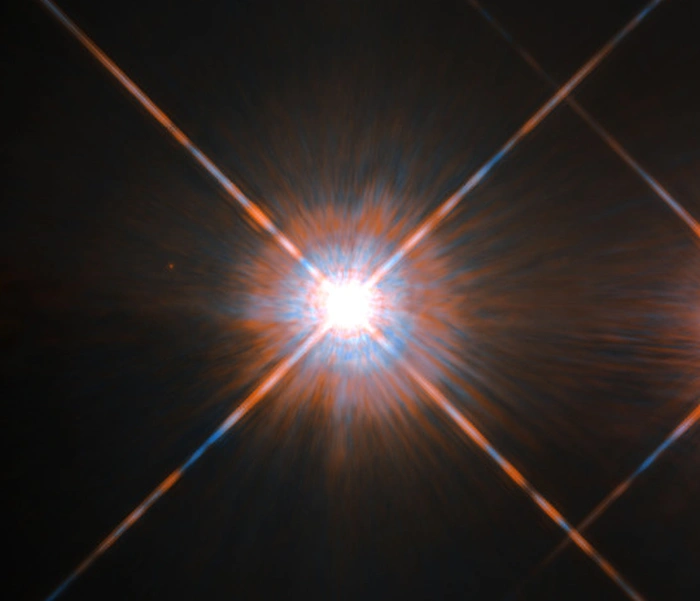
Rigil Kentaurus (Alpha Centauri A), image: ESA/NASA (CC BY 4.0)
Star type
Rigil Kentaurus is a main sequence star of the spectral type G2V. It is slightly larger and more massive than the Sun, with a mass of 1.0788 solar masses and a radius of about 1.2175 solar radii. With an effective temperature of 5,804 K, the star is 1.5059 times more luminous than the Sun. It has a projected rotational velocity of 2.7 km/s and takes about 28.3 days to complete a rotation.
Alpha Centauri A and its close neighbour Alpha Centauri B (Toliman) are both older than the Sun. They have an estimated age of 5.26 billion years.
The reported apparent magnitude of Rigil Kentaurus slightly differs from catalogue to catalogue. In the Bright Star Catalogue and the Hipparchos and Tycho Catalogues (1997), it is -0.01, while the 2007 Hipparcos (New Reduction) lists a magnitude of +0.1373. The Tycho-2 Catalogue gives a value of +0.137. The yellow dwarf exhibits coronal variability due to star spots coupled with the effects of rotation.
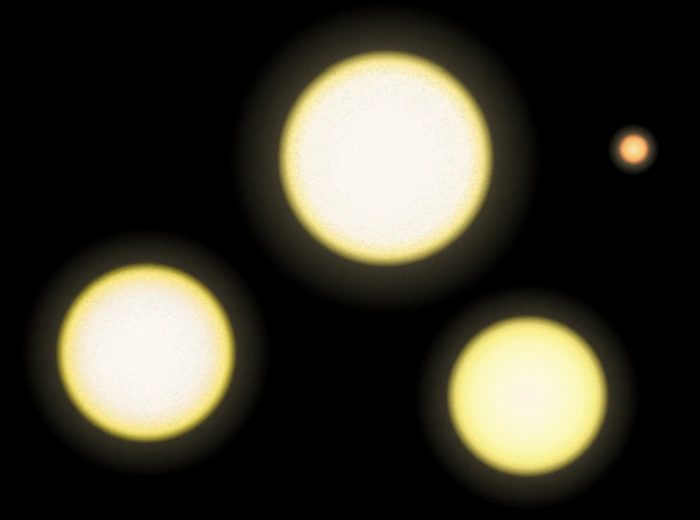
This diagram illustrates, from left to right, the relative size of the Sun, α Centauri A, α Centauri B and Proxima Centauri. Image credit: Wikimedia Commons/RJHall (CC BY-SA 3.0)
Star system
Rigil Kentaurus (Alpha Centauri A) is the brightest component of the Alpha Centauri system, which also includes Toliman (Alpha Centauri B) and Proxima Centauri (Alpha Centauri C). Toliman is a class K1V main sequence star and Proxima is a red dwarf of the spectral type M5.5Ve. At a distance of 4.2465 light-years, Proxima is the nearest star to our own Sun. It is the only component of the Alpha Centauri system that is invisible to the unaided eye. It has an apparent magnitude of 10.43 – 11.1.
Together with the smaller, cooler and less massive Toliman, Rigil Kentaurus forms the Alpha Centauri AB binary star system. The two components appear as a single star with an apparent magnitude of -0.27 to the unaided eye. They orbit around a common centre of mass with a period of 79.762 ± 0.019 years and an eccentricity of 0.51947. Because they have an eccentric orbit, the distance between them varies from 11.2 to 35.6 astronomical units. The two stars can be resolved in binoculars or a small telescope through most of their orbit.
Like Rigil Kentaurus, Toliman is a first-magnitude star. With an apparent magnitude of 1.33, it would appear slightly brighter than Regulus in the constellation Leo if it did not lie in the same line of sight as Alpha Centauri A.
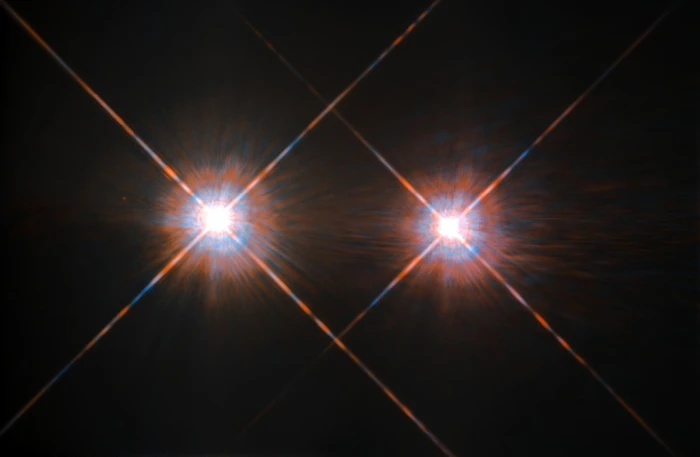
The closest star system to the Earth is the famous Alpha Centauri group. Located in the constellation of Centaurus (The Centaur), at a distance of 4.3 light-years, this system is made up of the binary formed by the stars Alpha Centauri A and Alpha Centauri B, plus the faint red dwarf Alpha Centauri C, also known as Proxima Centauri. The NASA/ESA Hubble Space Telescope has given us this stunning view of the bright Alpha Centauri A (on the left) and Alpha Centauri B (on the right), flashing like huge cosmic headlamps in the dark. The image was captured by the Wide Field and Planetary Camera 2 (WFPC2). WFPC2 was Hubble’s most used instrument for the first 13 years of the space telescope’s life, being replaced in 2009 by WFC3 during Servicing Mission 4. This portrait of Alpha Centauri was produced by observations carried out at optical and near-infrared wavelengths. Compared to the Sun, Alpha Centauri A is of the same stellar type G2, and slightly bigger, while Alpha Centauri B, a K1-type star, is slightly smaller. They orbit a common centre of gravity once every 80 years, with a minimum distance of about 11 times the distance between the Earth and the Sun. Because these two stars are, together with their sibling Proxima Centauri, the closest to Earth, they are among the best studied by astronomers. And they are also among the prime targets in the hunt for habitable exoplanets. Credit: ESA/Hubble & NASA (CC BY 4.0)
The apparent separation between the stars is always changing during their orbit. In 2019, they appeared 4.92 arcseconds apart and the separation increased to 5.49 arcseconds in 2020. The observed minimum separation was 1.7 arcseconds, while the maximum was about 22 arcseconds.
The faint red dwarf Proxima Centauri orbits the pair with a period of about 547,000 years at a distance that varies from 4,300 to 13,000 astronomical units. It is currently close to apastron (the widest separation).
Proxima is the only star in the Alpha Centauri system with confirmed exoplanets. The three planets, discovered in 2016, 2020 and 2022, are designated Proxima Centauri b, c and d. They are the nearest exoplanets to Earth. Proxima b and d have been confirmed, while Proxima c remains disputed. Proxima Centauri b is located in the star’s habitable zone.
Two planets were announced for Toliman in 2012 and 2013, but their existence has not been confirmed. The presence of the first one was ruled out within a year of the announcement.
Alpha Centauri A does not host any confirmed planets. However, a candidate planet, Alpha Centauri Ab was discovered by the James Webb Space Telescope (JWST) in 2025. To be in the star’s habitable zone, a planet would need to have an orbital radius between 1 and 2 astronomical units.
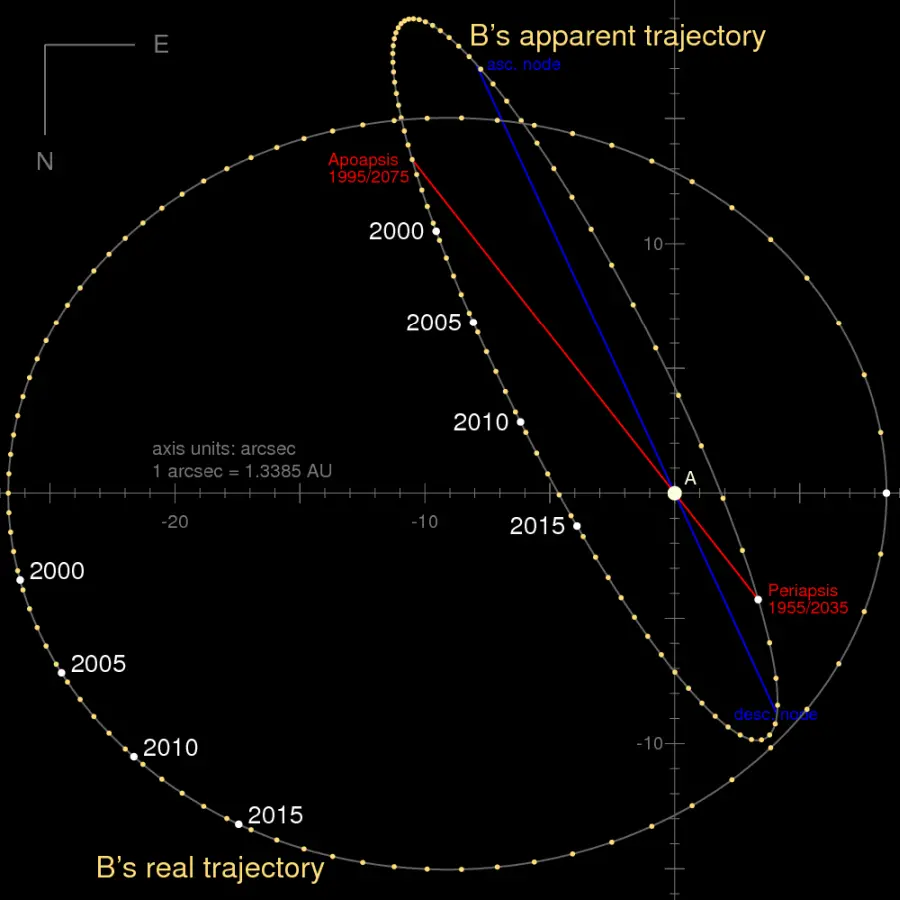
Trajectory of Alpha Centauri B relative to A (fixed to the coordinate origin) as seen from the Earth (inclined ellipse) and face-on (horizontal ellipse). The orbit parameters are taken from Pourbaix et al. (2002). Image credit: Wikimedia Commons/SiriusB (CC BY-SA 3.0)
Planet
The candidate planet Alpha Centauri Ab (Rigil Kentaurus b, Candidate 1, C1) was directly imaged by the James Webb Space Telescope (JWST) in February 2021 and reported in 2025. If the planet is confirmed, it will be the nearest directly imaged exoplanet orbiting a Sun-like star.
The candidate planet is believed to be a gas giant with a mass between 90 and 150 Earth masses, a radius of about 1 – 1.1 Jupiter radii (3.3 – 11 Earth radii), and a temperature of 225 K (-48° C, -55° F). If it is real, the planet orbits Rigil Kentaurus with a period of 2-3 years with an eccentricity of 0.4. It has an orbital distance of 2 astronomical units (AU).

This artist’s concept shows what the gas giant orbiting Alpha Centauri A could look like. Observations of the triple star system Alpha Centauri using the NASA/ESA/CSA James Webb Space Telescope indicate the potential gas giant, about the mass of Saturn, orbiting the star by about two times the distance between the Sun and Earth. In this concept, Alpha Centauri A is depicted at the upper left of the planet, while the other Sun-like star in the system, Alpha Centauri B, is at the upper right. Our Sun is shown as a small dot of light between those two stars. Credit: NASA, ESA, CSA, STScI, R. Hurt (Caltech/IPAC) (CC BY 4.0)
The planet was detected as a point source during observations with Webb’s mid-infrared instrument (MIRI) in August 2024. It is believed to be the same object previously spotted in 2021.
The candidate planet was confirmed not to be a foreground or background object. However, it was not detected during observations in February and April 2025. Astronomers believe that it was not spotted because of orbital motion.
The study reporting the discovery of Candidate 1 was authored by a research team led by Charles Beichman of the NASA Exoplanet Science Institute, Infrared Processing and Analysis Center, California Institute of Technology (Caltech). It was published in The Astrophysical Journal Letters in August 2025.
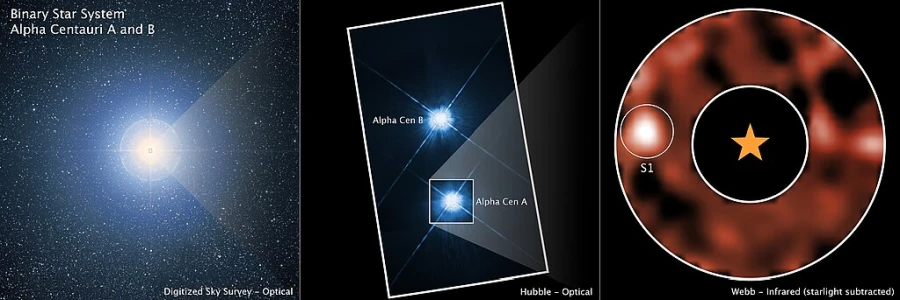
This image shows the Alpha Centauri star system from several different ground- and space-based observatories: the Digitized Sky Survey (DSS), the NASA/ESA Hubble Space Telescope, and the NASA/ESA/CSA James Webb Space Telescope. Alpha Centauri A is the third brightest star in the night sky, and the closest Sun-like star to Earth. The ground-based image from DSS shows the triple system as a single source of light, while Hubble resolves the two Sun-like stars in the system, Alpha Centauri A and Alpha Centauri B. The image from Webb’s MIRI (Mid-Infrared Instrument), which uses a coronagraphic mask to block the bright glare from Alpha Centauri A, reveals a potential planet orbiting the star. Credit: NASA, ESA, CSA, STScI, DSS, A. Sanghi (Caltech), C. Beichman (JPL), D. Mawet (Caltech), J. DePasquale (STScI) (CC BY 4.0)
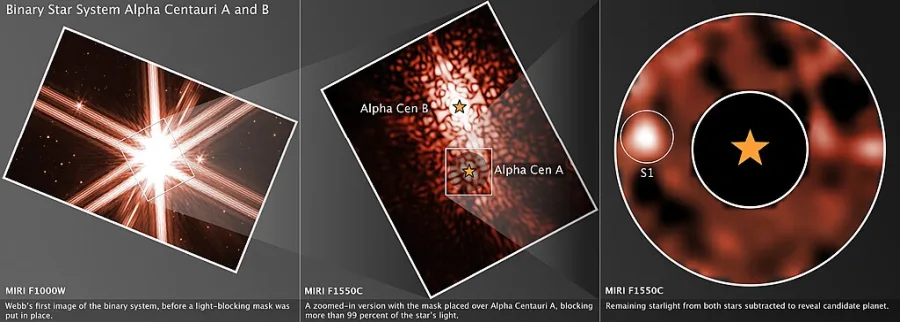
This 3-panel image captures the NASA/ESA/CSA James Webb Space Telescope’s observational search for a planet around the nearest Sun-like star, Alpha Centauri A. The initial image shows the bright glare of Alpha Centauri A and Alpha Centauri B, then the middle panel shows the system with a coronagraphic mask placed over Alpha Centauri A to block its bright glare. However, the way the light bends around the edges of the coronagraph creates ripples of light in the surrounding space. The telescope’s optics (its mirrors and support structures) cause some light to interfere with itself, producing circular and spoke-like patterns. These complex light patterns, along with light from the nearby Alpha Centauri B, make it incredibly difficult to spot faint planets. In the panel at the right, astronomers have subtracted the known patterns (using reference images and algorithms) to clean up the image and reveal faint sources like the candidate planet. Credit: NASA, ESA, CSA, STScI, A. Sanghi (Caltech), C. Beichman (JPL), D. Mawet (Caltech), J. DePasquale (STScI) (CC BY 4.0)
Facts
The binary nature of Alpha Centauri was discovered by Father Jean Richaud, a Jesuit priest, in December 1689, while observing a comet.
The system’s proximity was confirmed by the Scottish astronomer Thomas Henderson, who made his observations at the Royal Observatory at the Cape of Good Hope in South Africa in 1832-33. Henderson measured the system’s parallax after the British astronomer Manuel John Johnson had reported the stars’ high proper motion. However, Henderson did not publish his results until 1839 because he thought the values were too high to be accurate. For this reason, even though Alpha Centauri was the first star to have its parallax measured, it is often cited as the second, because the German astronomer Friedrich Wilhelm Bessel released a parallax for 61 Cygni in 1838.
Rigil Kentaurus is one of the 58 stars that have a special status in the field of celestial navigation. It is one of three navigational stars in Centaurus. The other two are the fainter Hadar (Beta Centauri) and Menkent (Theta Centauri). The three stars belong to a group of 18 southern navigational stars with a declination between 30° S and 90° S. Other stars in this group are Acrux and Gacrux in the neighbouring constellation Crux, Canopus, Miaplacidus and Avior in Carina, Achernar and Acamar in Eridanus, Kaus Australis in Sagittarius, Peacock in Pavo, Shaula in Scorpius, Atria in Triangulum Australe, Alnair in Grus, Suhail in Vela, Fomalhaut in Piscis Austrinus, and Ankaa in Phoenix.
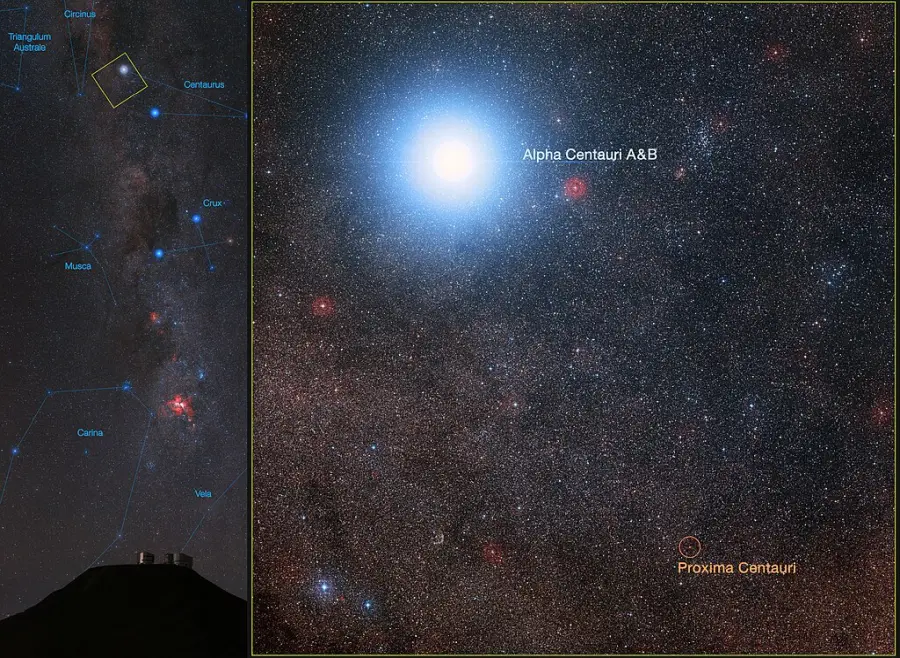
This image shows the closest stellar system to the Sun, the bright double star Alpha Centauri AB and its distant and faint companion Proxima Centauri. In late 2016 ESO signed an agreement with the Breakthrough Initiatives to adapt the VLT instrumentation to conduct a search for planets in the Alpha Centauri system. Such planets could be the targets for an eventual launch of miniature space probes by the Breakthrough Starshot Initiative. Credit: ESO/B. Tafreshi (twanight.org)/Digitized Sky Survey 2 ; Acknowledgement: Davide De Martin/Mahdi Zamani (CC BY 4.0)
Name
The name Rigil Kentaurus (pronunciation: /ˈraɪdʒəl kɛnˈtɔːrəs/) is derived from the Arabic Rijl al-Qinṭūrus, meaning “the foot of the Centaur.” It refers to the star’s position in the constellation Centaurus. The name was originally used for the whole Alpha Centauri system and now it formally applies only to its brightest component, Alpha Centauri A. The system’s other traditional name, Toliman, is now formally used for Alpha Centauri B.
The International Astronomical Union’s (IAU) Working Group on Star Names (WGSN) approved the name Rigil Kentaurus on November 6, 2016.
Rigil Kentaurus has also been known as Rigil Kent or simply Rigil. The name has the same origin as Rigel, the name of Beta Orionis, the bright blue supergiant at the foot of Orion.

This wide-field image shows the Milky Way stretching across the southern sky. The beautiful Carina Nebula (NGC 3372) is seen at the right of the image glowing in red. It is within this spiral arm of our Milky Way that the bright star cluster NGC 3603 resides. At the centre of the image is the constellation of Crux (The Southern Cross). The bright yellow/white star at the left of the image is Alpha Centauri, in fact a system of three stars, at a distance of about 4.4 light-years from Earth. The star Alpha Centauri C, Proxima Centauri, is the closest star to the Solar System. Image credit: A. Fujii (CC BY 4.0)
Location
Rigil Kentaurus is very easy to find because it is part of the Alpha Centauri system, the third brightest point of light in the night sky. It is located near Hadar (Beta Centauri) and the Southern Cross, a bright southern asterism commonly used to find the south celestial pole.
Alpha and Beta Centauri are called the Southern Pointers because they point towards the Southern Cross. A line extended from Rigil Kentaurus through Hadar leads to Gacrux (Gamma Crucis) at the top of the Southern Cross.
Alpha Centauri is invisible to most northern observers. It lies in the far southern sky and never rises above the horizon for observers north of the latitude 29° N. From northern tropical latitudes, it only appears low above the horizon at certain times of the year. South of the latitude 29° S, the star system is circumpolar, i.e. it never sets and can be seen year-round.
Alpha Centauri is at its highest point in the sky at midnight on April 24 and around 9 pm on June 8.
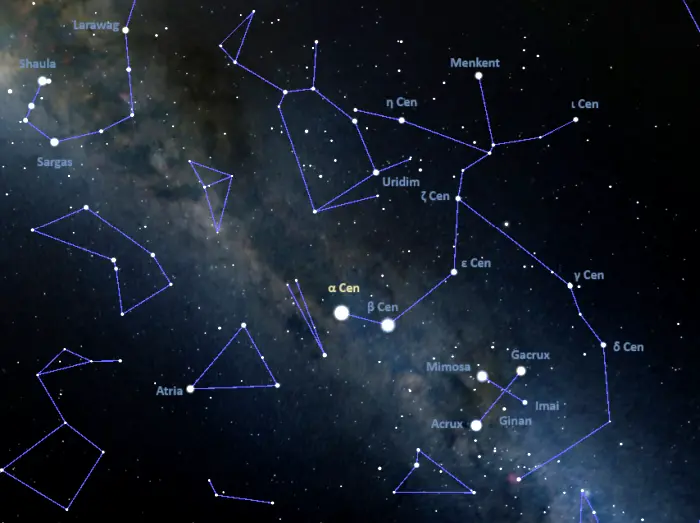
Location of Alpha Centauri, image: Stellarium
Constellation
Rigil Kentaurus is located in the constellation Centaurus. Stretching across 1,060 square degrees, Centaurus is the ninth largest constellation in the sky. It has been known since ancient times and is one of the ancient Greek constellations, first listed by the Greek astronomer Ptolemy in his Almagest in the 2nd century CE.
With 10 stars brighter than magnitude 3.00, Centaurus is also one of the brightest constellations. It contains the third and 11th brightest stars in the sky, Alpha and Beta Centauri. It is also home to the Diamond Star (Lucy), a white dwarf with a crystallized core, and HR 5171 (V766 Centauri), one of the largest stars ever discovered.
Other than Alpha and Beta Centauri, bright stars in Centaurus include the orange giant Menkent (Theta Centauri), the A-type binary star Gamma Centauri, the blue giants Epsilon Centauri and Lambda Centauri, the blue main sequence stars Eta Centauri and Delta Centauri, the B-type binary system Zeta Centauri (Leepwal), and the A-type main sequence star Iota Centauri (Kulou).
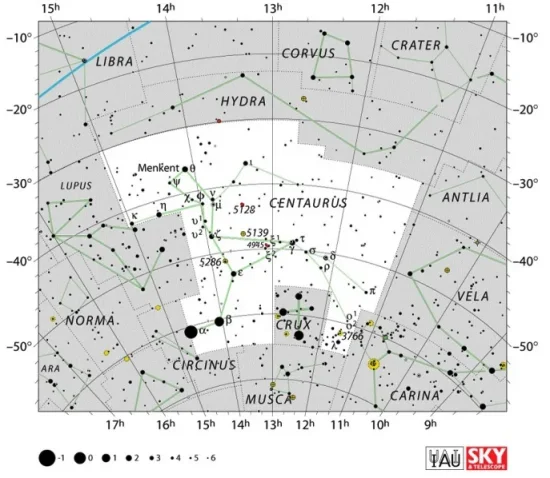
Centaurus constellation map by IAU and Sky&Telescope magazine (Roger Sinnott & Rick Fienberg) (CC BY 3.0)
Notable deep sky objects in Centaurus include the bright, large globular cluster Omega Centauri (NGC 5139), the emission nebula IC 2944 (the Running Chicken Nebula), the planetary nebula NGC 3918 (also known as the Blue Planetary or the Southerner), the protoplanetary nebula ESO 172-7 (the Boomerang Nebula), the bright starburst galaxy Centaurus A (NGC 5128), the irregular galaxy NGC 5253, the elliptical galaxy NGC 4696, the spiral galaxies NGC 4945 and NGC 4622, the polar-ring lenticular galaxy NGC 4650A, and the open clusters NGC 3766 and NGC 5460.
Despite its brightness and size, Centaurus is largely unknown to northern observers because it never rises very high above the horizon from locations in northern latitudes, if it appears at all. South of the equator, however, the constellation is circumpolar, i.e. it never sets and can be seen throughout the year.
The best time of the year to see the stars and deep sky objects in Centaurus is during the month of May, when the constellation is particularly prominent in the evening sky. The entire constellation is visible from locations between the latitudes 25° N and 90° S.
The 10 brightest stars in Centaurus are Alpha Centauri (mag. -0.27), Hadar (Beta Cen, mag. 0.61), Menkent (Theta Cen, mag. 2.06), Gamma Centauri (mag. 2.17), Epsilon Centauri (mag. 2.30), Eta Centauri (mag. 2.35), Leepwal (Zeta Cen, mag. 2.55), Delta Centauri (mag. 2.57), Kulou (Iota Cen, mag. 2.73), and Lambda Centauri (mag. 3.13).
Rigil Kentaurus – Alpha Centauri A
| Spectral class | G2V |
| U-B colour index | +0.24 |
| B-V colour index | +0.71 |
| Apparent magnitude | +0.01 |
| Absolute magnitude | 4.38 |
| Distance | 4.344 ± 0.002 light-years (1.3319 ± 0.0007 parsecs) |
| Parallax | 750.81 ± 0.38 mas |
| Radial velocity | −15.252000 ± 0.167000 km/s |
| Proper motion | RA: −3679.25 ± 3.89 mas/yr |
| Dec.: 473.67 ± 3.24 mas/yr | |
| Mass | 1.0788 ± 0.0029 M☉ |
| Luminosity | 1.5059 ± 0.0019 L☉ |
| Radius | 1.2175 ± 0.0055 R☉ |
| Temperature | 5,804 ± 13 K |
| Metallicity | 0.20 ± 0.01 dex |
| Age | 5.26 ± 0.95 billion years |
| Rotational velocity | 2.7 ± 0.7 km/s |
| Rotation | 28.3 ± 0.5 days |
| Surface gravity | 4.30 cgs |
| Constellation | Centaurus |
| Right ascension | 14h 39m 36.49400s |
| Declination | −60° 50′ 02.3737″ |
| Names and designations | Rigil Kentaurus, Rigil Kent, Alpha Centauri A, α Centauri A, α Cen A, Alpha1 Centauri, Alpha1 Centauri, Alpha1 Cen, α1 Centauri, α1 Cen, HD 128620, HR 5459, HIP 71683, SAO 252838, GJ 559 A, LHS 50, PPM 360911, SPOCS 610, CD-60 5293A, CPD-60 5483A, GCTP 3309.00, PLX 3309.00, GCRV 8517, SKY# 26645, CNS5 3627, CSI-60 5483 41, GEN# +1.00128620A, WEB 12354, LFT 1127, LTT 5806, NLTT 37984, PM 14362-6038A, PMSC 14328-6025A, SBC7 520, SBC9 815, Zkh 209, TD1 17606, GALAH 140708001701306, 2MASS J14393592-6050069, TIC 471011145, TYC 9007-5849-1, CCDM J14396-6050A, IDS 14328-6025 A, WDS J14396-6050A |